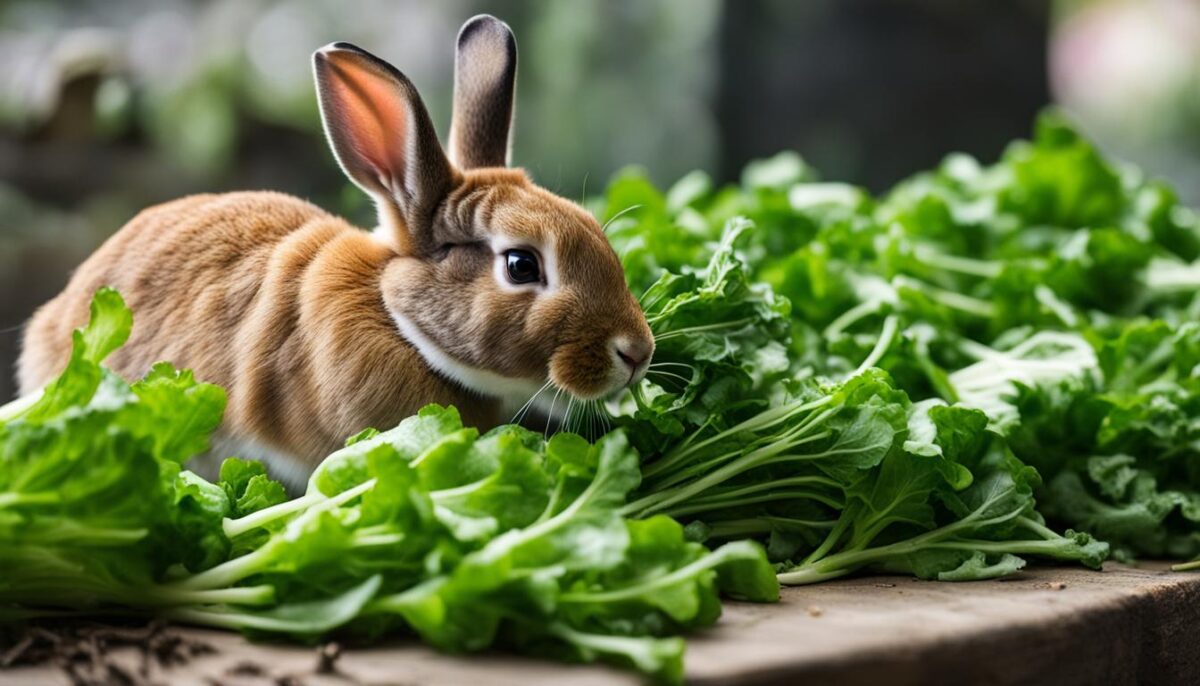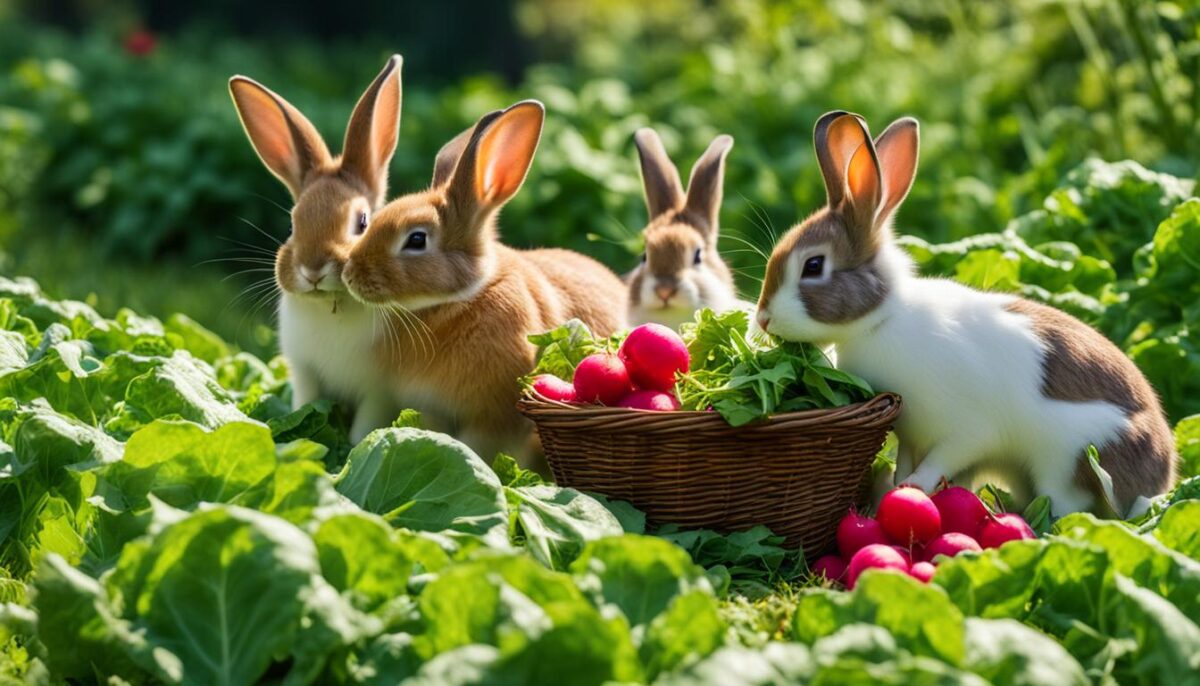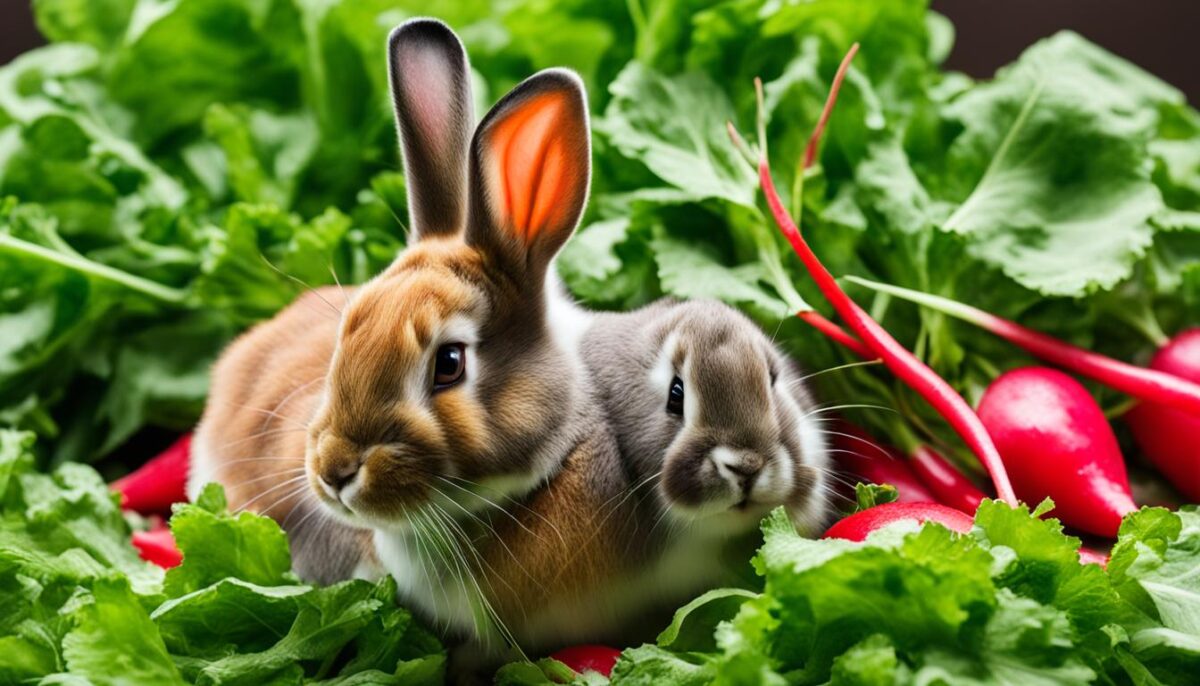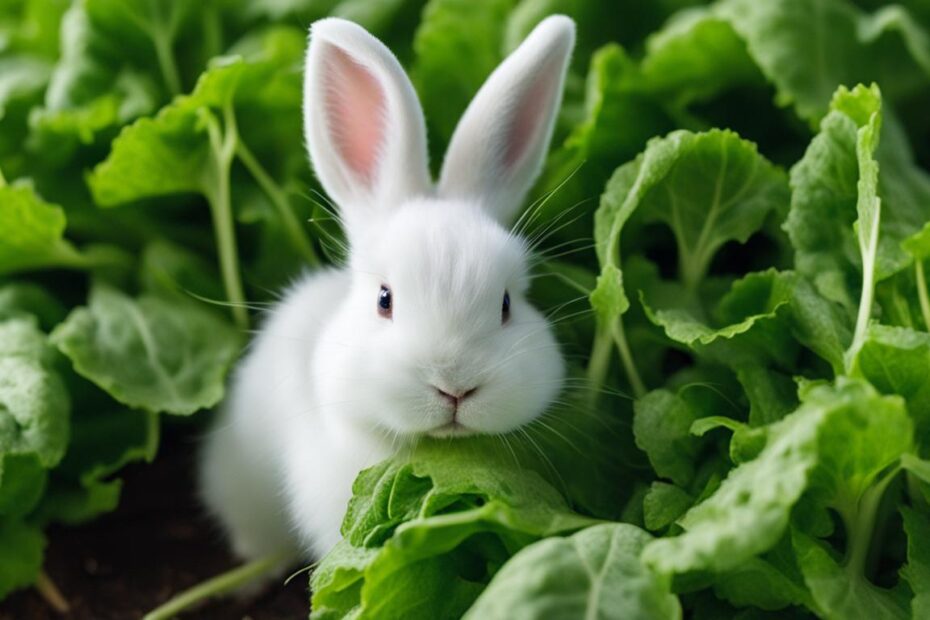Are you wondering whether it’s safe to feed your rabbit radish leaves and stems? We’ve got you covered! In this article, we’ll delve into the topic and provide you with all the information you need to know about incorporating radish leaves and stems into your rabbit’s diet.
Key Takeaways:
- Radish leaves and stems are safe for rabbits to eat in moderation.
- They are a good source of fiber and nutrients, making them a healthy choice for your bunny.
- Always wash radish leaves and stems thoroughly before feeding them to your rabbit to remove any pesticides.
- Introduce new foods gradually and monitor your rabbit’s reactions.
- Consult with a veterinarian for specific dietary recommendations for your rabbit.
A Healthy Rabbit Diet
The primary source of a rabbit’s diet should be high-quality hay, which should make up about 80% of their food intake. Hay is essential for rabbits as it helps maintain healthy digestion and keeps their teeth in good condition. Pellets can also be included in their diet, but should only make up a small portion of their daily intake. Look for pellets that are specifically formulated for rabbits and avoid those with added sugars or fillers. Fruits and vegetables should be given as treats and make up about 10% of their diet.
The Importance of Hay
Hay is the foundation of a healthy rabbit diet. It provides the necessary fiber to keep their digestive system functioning properly and prevents issues like hairballs. Additionally, the act of chewing on hay helps wear down their constantly growing teeth, preventing dental problems. Timothy hay is the most commonly recommended type of hay for rabbits, but other varieties like orchard grass and oat hay can also be fed.
Pellets: A Balanced Nutritional Supplement
Pellets can be given to rabbits in moderation to ensure they receive a balanced spread of nutrients. Pellets should be specifically formulated for rabbits and not mixed with those intended for other small animals. It is important to follow the recommended feeding guidelines based on your rabbit’s weight and age. Avoid overfeeding pellets as excessive consumption can lead to obesity and other health issues.
| Food | Serving Size |
|---|---|
| Hay | Unlimited |
| Pellets | 1/4 cup per 5 pounds of body weight |
| Vegetables | About a handful per day |
Fruits and Vegetables: Tasty Treats
Fruits and vegetables should be offered to rabbits in small quantities as treats. They not only provide additional nutrients but also add variety to their diet. Some safe options include leafy greens like kale, spinach, and romaine lettuce, as well as fruits like apples, strawberries, and blueberries. However, it is important to introduce new foods slowly and observe any changes in digestion or behavior. Too many sugary fruits can lead to digestive issues, so moderation is key.
Incorporating Radish Leaves and Stems into a Rabbit’s Diet
Radish leaves and stems can be a beneficial addition to a rabbit’s diet. They provide additional fiber and nutrients, contributing to the overall health of your furry friend. When incorporating radish leaves and stems into your rabbit’s diet, it’s important to introduce them gradually and monitor your rabbit’s reaction. Some rabbits may enjoy the taste and texture of radish greens, while others may have a less enthusiastic response. Always offer a balanced variety of leafy greens to ensure your rabbit’s diet is well-rounded.
Feeding radish leaves and stems to rabbits can have several benefits. These greens are rich in fiber, which aids in proper digestion and can help prevent gastrointestinal issues. Additionally, radish leaves and stems contain essential nutrients such as vitamins A and C, which are important for maintaining good overall health in rabbits. The inclusion of radish greens in a rabbit’s diet can provide variety and contribute to a more diverse range of nutrients.
It is important to note that while radish leaves and stems can be a healthy addition to a rabbit’s diet, they should not be the sole focus. A well-balanced rabbit diet should consist of primarily hay, with additional elements such as pellets, fruits, and vegetables in moderation. Remember to always wash radish leaves and stems thoroughly before feeding them to your rabbit to remove any pesticides or harmful chemicals. By incorporating radish leaves and stems into your rabbit’s diet, you can provide them with a diverse and nutritious meal plan.
The Benefits of Feeding Radish Leaves and Stems to Rabbits
- Rich in fiber, aiding in digestion
- Contain essential nutrients like vitamins A and C
- Provide variety in a rabbit’s diet
- Contribute to a well-rounded and nutritious meal plan
Feeding radish leaves and stems to rabbits can enhance their overall health and well-being. By incorporating these greens into their diet, you are providing them with valuable fiber and essential nutrients. Remember, moderation is key when it comes to introducing new foods, so always observe your rabbit’s response and consult with a veterinarian if you have any concerns.
Can Rabbits Consume Radish Greens?
Rabbits can certainly consume radish greens as part of their diet. Radish greens, also known as radish leaves, are highly nutritious and can provide additional fiber and essential nutrients to support your rabbit’s overall health. These greens are low in sugar and high in fiber, which makes them a healthy addition to their leafy greens.
When introducing radish greens to your rabbit’s diet, it is important to do so gradually and observe their reaction. Some rabbits may take to radish greens eagerly, while others may show less interest. It is essential to provide a varied selection of greens to ensure your rabbit receives a diverse range of nutrients.
Incorporating radish greens into your rabbit’s diet can offer numerous benefits. The high fiber content promotes healthy digestion, while the vitamins and minerals contribute to overall well-being. However, moderation is key, as with any new food. Start by offering a small portion of radish greens and monitor your rabbit’s response. If they tolerate it well, you can continue to include radish greens as part of their leafy green options.
| Nutritional Content of Radish Greens | Quantity |
|---|---|
| Fiber | 1.6g |
| Protein | 1.9g |
| Calcium | 49mg |
| Vitamin C | 25mg |
As with any fresh produce, it is important to wash radish greens thoroughly before offering them to your rabbit. This ensures the removal of any dirt, pesticides, or harmful chemicals that may be present. Always prioritize your rabbit’s safety and well-being by providing clean, fresh, and properly prepared foods.

Rabbits and Radish Tops
Radish tops, also known as radish leaves or greens, can be a nutritious addition to a rabbit’s diet. These leafy greens are packed with fiber and essential nutrients, making them a healthy choice for your furry friend. Including radish tops in your rabbit’s diet can provide variety and add a different taste and texture to their meals.
Feeding radish tops to rabbits is a simple process. Ensure that you wash the radish tops thoroughly to remove any dirt or residues before offering them to your rabbit. You can offer radish tops as part of their leafy greens, alongside other safe vegetables like parsley, spinach, or carrot tops. Remember that leafy greens should only make up a small portion of your rabbit’s diet, so offer them in moderation.
Radish tops are a great source of fiber and nutrients for rabbits. Including them in your rabbit’s diet can provide variety and promote a well-rounded nutritional intake.
As with any new addition to your rabbit’s diet, it’s important to introduce radish tops gradually and observe your rabbit’s reaction. Some rabbits may enjoy the taste and texture of radish tops, while others may not show much interest. Always monitor your rabbit’s overall health and digestive system when introducing new foods.
Table: Comparison of Nutritional Content in Radish Tops and Other Leafy Greens
| Leafy Green | Fiber Content (per 100g) | Vitamin A Content (IU per 100g) | Vitamin C Content (mg per 100g) |
|---|---|---|---|
| Radish Tops | 1.6g | 3,450 IU | 30 mg |
| Parsley | 3.3g | 5,370 IU | 133 mg |
| Spinach | 2.2g | 2,813 IU | 28 mg |
| Carrot Tops | 2.8g | 10,977 IU | 5.9 mg |
As shown in the table above, radish tops offer a moderate amount of fiber and essential vitamins. While they may not have the highest nutrient content compared to other leafy greens, they still provide valuable benefits to a rabbit’s diet. Remember to offer your rabbit a varied selection of leafy greens to ensure they receive a diverse range of nutrients.
Incorporating Radishes into a Rabbit’s Diet
While radishes themselves can be safely consumed by rabbits, they should not be a regular part of their diet. Radishes have a high sugar content, which can lead to digestive issues if consumed in large quantities. However, radishes can be offered as an occasional treat, providing a small amount for your rabbit to enjoy. It is important to monitor your rabbit’s reaction to radishes and adjust the amount accordingly.
When incorporating radishes into a rabbit’s diet, it is crucial to introduce them gradually. Start by offering a small piece of radish and observe how your rabbit responds. Some rabbits may enjoy the taste and texture, while others may be less interested. Remember to wash the radish thoroughly before feeding it to your rabbit to remove any dirt or pesticides.
Consulting with a veterinarian is always recommended, especially if you have concerns about your rabbit’s diet. They can provide personalized guidance and ensure that your rabbit’s nutritional needs are met. In addition to radishes, there are many other safe vegetables that can be incorporated into a rabbit’s diet. Providing a variety of vegetables ensures that your rabbit gets a diverse range of nutrients.

Table: Safe Vegetables for Rabbits
| Vegetable | Serving Size |
|---|---|
| Parsley | Small handful |
| Spinach | Small handful |
| Mustard Greens | Small handful |
| Beetroot Greens | Small handful |
| Swiss Chard | Small handful |
| Carrot Tops | Small handful |
| Cucumber Leaves | Small handful |
These vegetables should be given in moderation as part of a balanced and varied diet. Always wash them thoroughly before feeding them to your rabbit. Remember, a healthy diet for your rabbit is key to their overall well-being.
Other Safe Vegetables for Rabbits
Aside from radish leaves and stems, there are several other vegetables that are safe and nutritious for rabbits to consume. These vegetables can be added to a rabbit’s diet to provide variety and additional nutrients. Here are some examples of safe vegetables for rabbits:
- Parsley
- Spinach
- Mustard greens
- Beetroot greens
- Swiss chard
- Carrot tops
- Cucumber leaves
These leafy greens can be given to rabbits in moderation, alongside their regular hay and pellets. It is important to wash all vegetables thoroughly before feeding them to your rabbit, as this helps remove any pesticides or harmful chemicals that may be present. By incorporating a variety of safe vegetables into your rabbit’s diet, you can ensure they receive a well-rounded and nutritious meal.
Benefits of Safe Vegetables for Rabbits
Safe vegetables, such as the ones mentioned above, provide rabbits with essential vitamins, minerals, and fiber. These nutrients contribute to their overall health and well-being. Leafy greens are particularly beneficial for rabbits as they help support healthy digestion and promote dental health. Including a variety of safe vegetables in a rabbit’s diet also helps prevent boredom and encourages natural foraging behaviors.
Feeding Safe Vegetables in Moderation
While safe vegetables offer numerous health benefits for rabbits, it is important to feed them in moderation. Vegetables should only make up a small portion of a rabbit’s overall diet, with the majority being hay. Too many vegetables can lead to digestive problems, so it is crucial to offer them as treats rather than as a primary food source. Always introduce new vegetables gradually, observing your rabbit’s response and adjusting the quantities accordingly.
| Vegetable | Nutritional Benefits |
|---|---|
| Parsley | Rich in vitamin C and antioxidants |
| Spinach | Good source of iron, vitamins A and K |
| Mustard greens | High in vitamin C and fiber |
| Beetroot greens | Contain vitamin C, iron, and magnesium |
| Swiss chard | Rich in vitamins A, C, and K |
| Carrot tops | Good source of vitamin A and fiber |
| Cucumber leaves | High in water content and refreshing |
Offering a variety of safe vegetables to your rabbit not only enhances their diet but also adds excitement and enrichment to their mealtime. Remember to consult with a veterinarian for specific dietary recommendations for your rabbit to ensure their nutritional needs are met.
Incorporating Radish Leaves and Stems into a Rabbit’s Diet
Radish leaves and stems can be a nutritious addition to a rabbit’s diet, providing fiber and essential nutrients. Including these leafy greens in your rabbit’s meals can offer variety and contribute to their overall well-being.
When incorporating radish leaves and stems into your rabbit’s diet, it is important to introduce them gradually and monitor your rabbit’s reaction. While some rabbits may enjoy the taste and texture of radish greens, others may not show as much interest. Offering a balanced variety of leafy greens ensures that your rabbit receives a diverse range of nutrients.
Remember to always wash radish leaves and stems thoroughly before feeding them to your rabbit, removing any dirt or pesticides. This helps ensure the safety and health of your furry friend. By incorporating radish leaves and stems into your rabbit’s diet, you can provide them with a nutritious and enjoyable meal.

| Benefits of Incorporating Radish Leaves and Stems into a Rabbit’s Diet |
|---|
| 1. Nutrient-rich: Radish leaves and stems are packed with essential vitamins and minerals that support your rabbit’s overall health. |
| 2. Fiber source: The high fiber content in radish greens promotes healthy digestion and helps prevent gastrointestinal issues. |
| 3. Added variety: Including radish leaves and stems in your rabbit’s diet adds variety to their meals, making feeding time more interesting. |
| 4. Hydration: Radish leaves and stems have a high water content, contributing to your rabbit’s hydration. |
Further Reading
If you want to delve deeper into the topic of rabbit diets and explore more foods that are safe for your furry friend, there are several resources available. These articles provide detailed information on specific foods, including bananas and tomatoes, in order to help you make informed decisions about your rabbit’s diet.
By reading these articles, you can gain a better understanding of what foods are suitable for rabbits and what should be avoided. This knowledge will enable you to provide a well-balanced and nutritious diet for your rabbit, promoting their overall health and well-being.
Remember, it’s always a good idea to consult with a veterinarian for personalized guidance concerning your rabbit’s diet. They can provide expert advice tailored to your rabbit’s specific needs, ensuring they receive the best possible care and nutrition.
FAQ
Can rabbits eat radish leaves and stems?
Yes, radish leaves and stems can be safely included in a rabbit’s diet. They are a good source of fiber and nutrients, making them a healthy choice for rabbits. However, moderation is key, as too much can cause digestive issues. It is important to always wash radish leaves and stems thoroughly to remove any pesticides or harmful chemicals before feeding them to your rabbit.
What is the most important component of a rabbit’s diet?
The most important component of a rabbit’s diet is hay, which should make up about 80% of their food intake. Hay is beneficial for their digestive system and dental health. Pellets can also be given in moderation, providing a balanced spread of nutrients. Fruits and vegetables should be considered as treats and given in limited quantities, about a handful a day. It is important to provide a varied diet to ensure your rabbit gets all the necessary nutrients.
How can radish leaves and stems be incorporated into a rabbit’s diet?
Radish leaves and stems can be incorporated into a rabbit’s diet as part of their leafy greens. They provide additional fiber and nutrients, which can be beneficial for their overall health. However, it is important to introduce new foods gradually and monitor your rabbit’s reaction. Some rabbits may enjoy radish leaves and stems, while others may not show much interest. Always offer a balanced variety of leafy greens to ensure your rabbit’s diet is well-rounded.
Can rabbits consume radish greens?
Yes, rabbits can consume radish greens. In fact, radish greens are more nutritious for them than the radish itself. They are high in fiber and low in sugar, making them a healthy addition to a rabbit’s diet. However, as with any new food, it is important to introduce radish greens gradually and observe your rabbit’s reaction. Some rabbits may enjoy the taste and texture of radish greens, while others may not show much interest. Always offer a varied selection of greens to ensure your rabbit gets a diverse range of nutrients.
Can rabbits eat radish tops?
Rabbits can eat radish tops, also known as radish leaves or greens. Radish tops are packed with fiber and nutrients, making them a healthy choice for rabbits. They can be offered as part of their leafy greens, providing variety and additional nutrients to their diet. It is important to wash radish tops thoroughly to remove any dirt or pesticides before feeding them to your rabbit.
Can rabbits eat radishes?
While radishes themselves can be safely consumed by rabbits, they should not be a regular part of their diet. Radishes have a high sugar content, which can lead to digestive issues if consumed in large quantities. It is best to offer radishes as an occasional treat, providing a small amount for your rabbit to enjoy. It is important to monitor your rabbit’s reaction to radishes and adjust the amount accordingly. Always introduce new foods gradually and consult with a veterinarian if you have any concerns.
What are some other safe vegetables for rabbits?
In addition to radish leaves and stems, there are many other vegetables that are safe for rabbits to consume. Some examples include parsley, spinach, mustard greens, beetroot greens, Swiss chard, carrot tops, and cucumber leaves. These vegetables should be given in moderation, as part of a balanced and varied diet. It is important to wash all vegetables thoroughly before feeding them to your rabbit to remove any pesticides or harmful chemicals.
What is the conclusion about incorporating radish leaves and stems into a rabbit’s diet?
Radish leaves and stems can be safely included in a rabbit’s diet, providing additional fiber and nutrients. It is important to offer a varied diet to ensure your rabbit gets all the necessary nutrients. While radishes themselves can also be given as an occasional treat, they should not be a regular part of a rabbit’s diet due to their high sugar content. Always introduce new foods gradually and monitor your rabbit’s reaction. Consult with a veterinarian for specific dietary recommendations for your rabbit.
Where can I find further reading on rabbit diets?
If you would like to learn more about specific foods that rabbits can and cannot eat, there are additional resources available. You can check out articles on topics such as “Can Rabbits Eat Bananas?” and “Can Rabbits Eat Tomatoes?” These articles provide in-depth information and dispel any rumors or myths about specific foods for rabbits. If you have any other questions or concerns about your rabbit’s diet, it is always best to consult with a veterinarian for personalized guidance.


